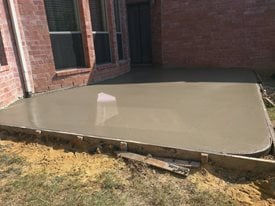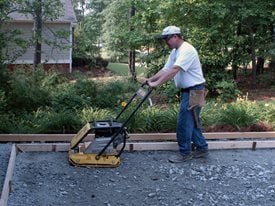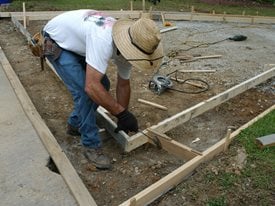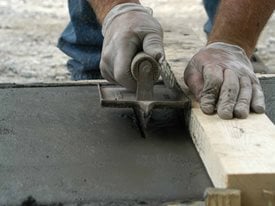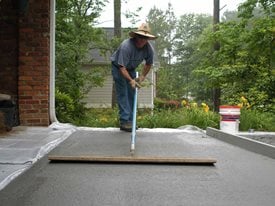If you’ve ever thought about trying to pour your own concrete patio in an attempt to cut costs or just for a sense of accomplishment, it’s important to be aware of all the ways your efforts could potentially fail and end up wasting money rather than saving it.
Find concrete patio contractors near me
Pouring a concrete patio slab — no matter how small — is not a simple home improvement project. It requires careful planning, backbreaking labor, and the proper tools and materials to achieve a successful outcome.
Can it be done? Sure, if you know what you’re doing. Can a lot go wrong? You can almost bet on it. Here are six reasons why pouring a new concrete patio, or extending an existing one, is better left to a professional.
1. Proper Subgrade Preparation is Hard Work
One of the most common reasons a DIY concrete patio fails is improper subgrade preparation. You can’t just excavate an area in your backyard and pour the concrete directly on dirt. The soil may not drain well, and it can be difficult to compact to the proper grade. To provide uniform support for your concrete patio slab, you’ll need to add compacted gravel or crushed stone to the area to create a solid base that will prevent erosion and slab settling.
Keep in mind that the minimum thickness for a concrete patio is 4 inches, and you’ll need to dig down another 3 inches for the gravel base, for a total excavation depth of 7 inches or more. If you plan on pouring a large concrete patio, you’ll want to rent a small excavator to do the digging rather than shoveling it out by hand. To properly compact your gravel base, you will also need to rent a vibratory plate compactor or tamper.
Learn more: Subgrades and Subbases for Concrete Slabs.
2. Assembling Concrete Forms is Tricky
Another important factor to achieving good results when laying out a concrete patio is how the forms are installed. Using the right forming system and installing it properly can have a big impact on the appearance of your concrete slab because it serves as the framework for your patio and gives you smooth, perfect edges.
The most basic forms for residential concrete slabs consist of 2x4 or 2x6 wood boards screwed or nailed to wood or metal stakes that are driven into the prepared subbase. In addition to cutting the form boards to size, you need install them at the proper slope for good patio drainage so you don’t get “bird baths” or puddles. Things get even more complicated when concrete patios with rounded edges or free-form shapes are desired.
Read more about concrete forms.
Related: How Much Concrete Do I Need for a Patio?
3. Reinforcement and Joints are Needed to Prevent Cracks
Even a small concrete patio can benefit from the installation of rebar or wire mesh to help prevent cracking and improve the concrete’s tensile strength. But if you plan on building a large patio or the patio will be supporting heavy structures such as a hot tub or outdoor fireplace, reinforcement is essential. Even with reinforcing rods or mesh in place, concrete slabs can crack over time due to movement caused by temperature changes and drying shrinkage. You’ll need to saw cut control joints into the concrete soon after final finishing to control where those cracks occur.
Learn more: Control Joints in Concrete.
4. THERE’S NO GUESSWORK WHEN MIXING CONCRETE
If you have never mixed a batch of concrete before, a patio project shouldn’t be your first attempt at it. Concrete is a high-tech, precisely proportioned material that contains more than sand, aggregate, cement, and water. It often includes admixtures and fiber reinforcement to enhance its performance and workability. It may also include integral pigments if colored concrete is desired.
Even though you can avoid much of the trial and error by using a preblended, bagged concrete mix that only requires the addition of water, using the right water-cement ratio and mixing the concrete thoroughly are crucial to achieving the proper consistency and optimum strength. Many of the problems experienced with concrete, including shrinkage and cracking, are due to adding more water than needed. And as convenient as bagged mixes are, they aren’t practical for large patio projects unless you buy or rent a portable concrete mixer.
See How to Mix Your Own Concrete and Dry Pour Concrete - Is It a Good Idea?
5. Finishing Concrete Requires Good Timing and Technique
Any professional concrete contractor will tell you that it often requires years of experience to master the timing of concrete finishing operations and the proper techniques to use. When finishing a concrete patio slab, timing is key because starting the process too soon can weaken the surface and cause dusting and craze cracking. And improper finishing techniques, such as overworking the concrete with a bull float or trowel, can result in an unattractive surface that will be impossible to correct. What’s more, your work isn’t done after final finishing. You still need to cure and seal the concrete so it can attain full strength and not lose moisture prematurely, which can lead to cracking.
Learn more about the tools and techniques required for finishing concrete.
6. Saving Money Can be Expensive
Mixing up and pouring your own concrete patio may save you money initially, but if you make any mistakes along the way, you could be facing substantial costs for concrete repair or replacement. Also keep in mind that you’ll need to shell out money for equipment, finishing tools, forming lumber, and other supplies. Hiring a professional concrete contractor is the best way to ensure that you get a concrete patio that is problem-free and has the finished look you desire. Plus, it may not be as expensive as you think. Installation of a simple concrete patio, with no decorative colors and finishes, can run as little as $3 to $6 per square foot (see Concrete Patio Cost).
If you’re still confident that you can place your own concrete patio after doing your research and knowing what’s involved, here is some guidance that can help you do it right: Guide to Pouring Concrete.
Related Information:
Stamped Concrete DIY
DIY Concrete Stain
Mistakes to Avoid When Pouring a Concrete Slab
